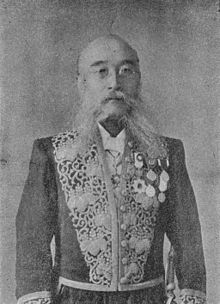In this Japanese name, the surname is Chisaka.
| Chisaka Takamasa | |
|---|---|
| 千坂 高雅 | |
 Portrait of Chisaka Takamasa Portrait of Chisaka Takamasa | |
| Personal details | |
| Born | March 11, 1841 Yonezawa Domain, Yamagata, Japan |
| Died | December 3, 1912(1912-12-03) (aged 71) |
| Parent |
|
| Occupation | Soldier, bureaucrat, businessman |
| Military service | |
| Rank | First lieutenant |
| Battles/wars | Satsuma Rebellion |
Chisaka Takamasa (千坂 高雅, March 11, 1841 – December 3, 1912) was a Japanese samurai of the late Edo period who went on to become a soldier, government official, and businessman in the Meiji era. He served as a karō in the Yonezawa Domain's administration.
Biography
Takamasa was born in 1841 to a prominent samurai family in Akita Prefecture of the Yonezawa Domain. He was the first son of Takaaki Chisaka, who was the chief retainer of the Yonezawa clan.
Government service
Takamasa entered official service in 1863 and five years later, in 1863, he was given command of the han military force. He was promoted as a dai-sanji (chief councilor) in 1870 and later accompanied the clan lord Shigenori Uesugi on his European tour. When he returned to Japan in 1875, he served in the government's Home Ministry. It is noted that his position in the ministry was not secure due to his Yonezawa roots. The installation of representatives of the central governments from among those who came from the abolished domains was not universally welcomed in the ministry.
In 1876 Takamasa would be called upon to put down the rebellion in the Ibaraki prefecture, and later in 1877, during the Satsuma Rebellion, he was appointed a first lieutenant in the army.
Private sector
After his retirement from government service, Takamasa joined the private sector, holding executive positions at companies such as the Ryou Ginko (Ryou Bank), Ujigawa Hydroelectric Power Station, and Yokohama Soko (Yokohama Warehouse).
Takamasa's career demonstrated the transition of the lives of the samurai from service to their lords to civil or government service in modern Japan. This development was also indicative of the relationships between the samurai and their previous lords. In the case of Takamasa, his former liege promoted his employment – as was done for other former samurai (shizoku jusan) of the Kanazawa – by getting his appointment as Nomi County Chief approved. He was later appointed as the governor of Ishikawa Prefecture.
Takamasa was the father of Captain Tomojiro Chisaka, the commander of the Yakumo, and Major Yojiro Chisaka, who served in the Imperial Army. He died on December 3, 1912, due to pleurisy and inflammation of the lungs.
References
- ^ Baxter, James C. (March 23, 2020). The Meiji Unification Through the Lens of Ishikawa Prefecture. BRILL. ISBN 978-1-68417-305-1.
- ^ "Chisaka, Takamasa | Portraits of Modern Japanese Historical Figures". www.ndl.go.jp. Retrieved June 16, 2020.
- ^ "Death of Mr. T. Chisaka". The Japan Times. 32 (1): 452. December 7, 1912.
- Saaler, Sven (October 12, 2020). Men in Metal: A Topography of Public Bronze Statuary in Modern Japan. BRILL. ISBN 978-90-04-44151-4.
- ^ Saaler, Sven (2020). Men in Metal: A Topography of Public Bronze Statuary in Modern Japan. Leiden: BRILL. p. 57. ISBN 978-90-04-41443-3.
- Baxter, James C. (1994). The Meiji Unification Through the Lens of Ishikawa Prefecture. Cambridge, MA: Harvard Univ Asia Center. p. 222. ISBN 0674564669.
- Checkland, Olive (2003). Japan and Britain After 1859: Creating Cultural Bridges. London: RoutledgeCurzon. p. 216. ISBN 0700717471.
- Checkland, Olive (August 29, 2003). Japan and Britain After 1859: Creating Cultural Bridges. Routledge. ISBN 978-1-135-78619-9.
External links
- Chisaka, Takamasa | Portraits of Modern Japanese Historical Figures at www.ndl.go.jp
- æPRãÄòËåEÝ ãÎö at www8.ocn.ne.jp